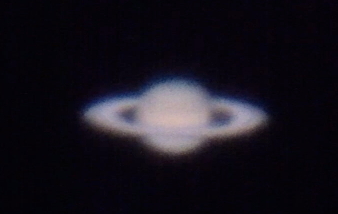
iPhone Imaging: Mars and Saturn
Posted: 15 May 2012
I had planned to open the observatory Sunday night, 13 May, but smoke from distant fires (no threat here) was too prevalent in my sky. Decided it would be best to not use the telescope. Monday, evening, 14 May 2012, I attended "Weather Spotter Training" offered by the National Weather Service. I am now an official "Weather Spotter".
After I returned home from the Weather Spotter training, I checked the sky condition. It was clear. And the Zodiacal Light was very bright in the western sky. I opened the observatory at 2113 MST, 76°F. At 2123 MST, viewed Mars, 77X. No features were visible. At 133X, a sunrise cloud and a dark area were visible. Unfortunately, seeing was not very good. I tried using higher magnifications but poor seeing preventing seeing any more detail on the planet. I then viewed Saturn, 77X. Four moons were visible: Dione, Rhea, Tethys, and Titan. I tried for Enceladus at 133X, 206X, and 364X, but no joy. Poor seeing, combined with planet glare, likely prevented seeing this moon.
I then set up for iPhone 4 afocal imaging (Camera app) using the MX-1 afocal adapter. I took single frame exposures and 45 second video recordings of Mars and Saturn at 444X + moon filter, and Saturn at 444X (without the moon filter) and 222X + moon filter. The video frames were stacked using Keith's Image Stacker. These are the resulting images, all cropped from the original full-frame images.
Single exposure, 444X + moon filter, same scale:


444X + moon filter; best single frame from video (left), 1089 frames stacked and upscaled 200% (right):


222X + moon filter; best single frame from video (left), 1094 frames stacked and upscaled 200% (right):


444X; best single frame from video (left), 1095 frames stacked (right):


These results provided good imaging tests on a night of poor seeing. Hopefully seeing will be better on another session.
Ended iPhone imaging at 2211 MST. At 2215 MST, viewed Centaurus A (galaxy), 77X. I added the LPR filter; contrast was increased but the filter reduced the brightness of the galaxy. Then viewed Omega Centauri (globular cluster), 77X + LPR filter. Same effect: increased contrast but low brightness. The view of Omega Centauri was significantly better without the filter. I then used 133X to view Omega Centauri; nice view, with many stars resolved. Tried 206X but that was too much magnification for the very low altitude at which Omega Centauri appears in my sky.
At 2248 MST, I began viewing some DSOs in various constellations at 77X. Hercules: M13 and M92 (globular clusters). Lyra: M57 (Ring Nebula) and M56 (globular cluster). Scorpius: M80 and M4 (globular clusters), NGC6124 and NGC6231 (open star clusters), NGC6302 (Bug Nebula, planetary nebula), and M6 (Butterfly Cluster, open cluster). I planned to image NGC6302 (Bug Nebula) after it rose high enough, but by 2338 MST, I was fading fast after a day of more yard work with the CFO (wife) and the Weather Spotter training in the evening. I decided to call it a night.
Closed the observatory at 2348 MST, 73°F.
Comments are welcome; use the Comments section below, or you can Email Me. Thanks.
Go to the previous report.
Return to the Cassiopeia Observatory Welcome Page.